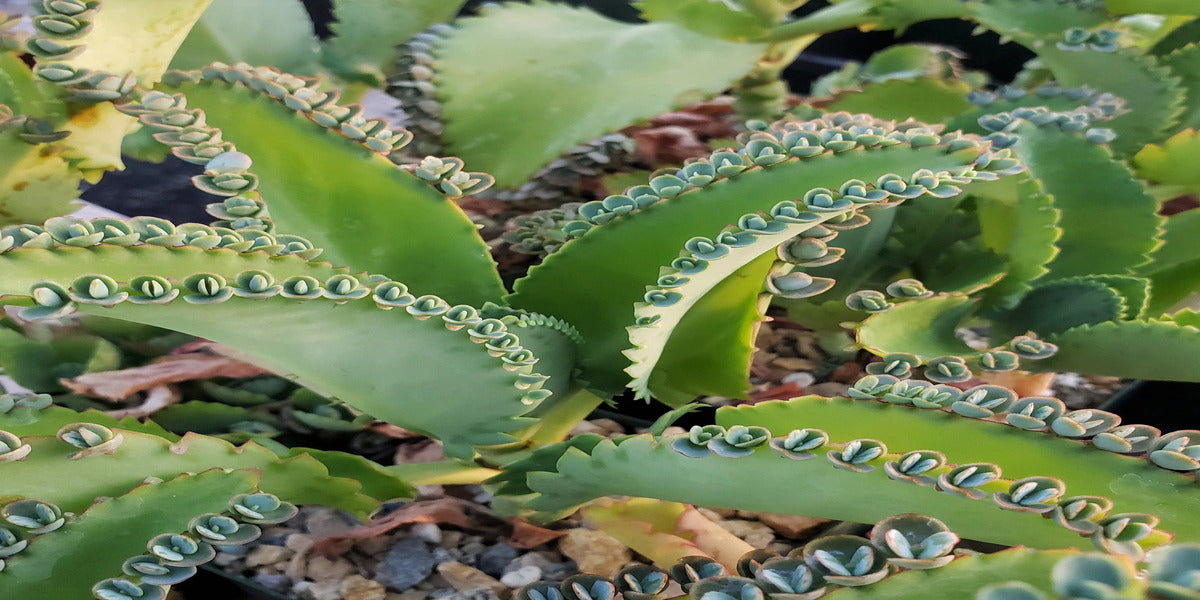Mother of Thousands Plants - Everything You Need to Know!
Updated: March 29, 2024

Mother of Thousands, also known as Kalanchoe laetivirens, is not only a cool addition to your houseplant collection, but it's also a hardy, low-maintenance succulent species. Originally hailing from Madagascar, the Mother of Thousands plants has made its way to different corners of the globe, captivating plant lovers and scientists along the way.
In this comprehensive guide from Planet Desert, we'll cover everything you need to know about Mother of Thousands plants - from their sun exposure needs to how to propagate by cuttings and a comparison to how it is different from Mother of Millions. So, let's get started!
All About Mother of Thousands Plant
The mother of thousands plant, also known as the devil's backbone, Mexican hat plant, and alligator plant, is a plant found in the Kalanchoe genus.
The mother of thousands has two species: Kalanchoe daigremontiana mother of thousands and Kalanchoe laetivirens. Both are part of the Crassulaceae family and have similar appearances, but the most noticeable difference is the dark purple stripes on the backside of the triangular leaves in the mother of thousands Kalanchoe daigremontiana, while the Kalanchoe laetivirens have solid green leaves. Regardless of which species you grow, the mother of thousands plant is truly remarkable.
The Mother of Thousands gets its name from its incredible ability to produce numerous plantlets along the edges of its leaves. These plantlets are like miniature versions of the plant, complete with their own roots. They look like tiny baby plants growing right on the edges of the leaves. These plantlets have the potential to detach from the parent leaf and grow into new, independent plants. It's like the Mother of Thousands is a nurturing parent, giving birth to a whole army of plant babies!

The Mother of Thousands typically grows in a rosette-like form, with the leaves arranged in a circular pattern.
The leaves themselves are quite broad and have a slightly elongated shape, giving the plant a lush and full appearance. It takes between two and five years to mature and can grow up to 2 feet tall and wide.
Each leaf is covered in a waxy coating, which not only adds to its visual appeal but also helps to retain moisture.
This adaptation allows your Kalanchoe mother of thousands to survive in arid environments where water may be scarce.
The leaves are one of the standout features of the Mother of Thousands. They are a gorgeous shade of green, and what's really cool is that they can also have hints of reddish or purplish tones along the edges.
Mother of Thousands Flowers
Kalanchoe Mother of Thousands succulents, primarily known for their attractive foliage, occasionally produce sporadic blooms, similar to their jade plant cousin. These mother of thousands plant flowers are sporadic and occur when the plant receives optimal light. The candelabra-like stem produces grayish-pink to orange bell-shaped flowers. The flowers usually appear in clusters on long stalks that emerge from the center of the plant.
If taken outdoors for summer, your Kalanchoe laetivirens mother of thousands will occasionally bloom after being brought indoors for winter.

Mother of Thousands Care
The low-maintenance Mother of Thousands is a hardy, drought-tolerant succulent plant that can handle intense heat like a champ! It's like a little sun-loving warrior that thrives in hot climates. However, it's not a big fan of frost, so if you live in a cold area, you'll want to protect it during the winter months. You should be aware of the following when it comes to the care and maintenance of your Kalanchoe mother of thousands.
Quick Reference

Bloom Season

Flower Color

Growth Rate

Hardiness Zone

Mature Size

Plant Type

Sun Exposure

Toxicity

Watering Needs
Golden Rules for Watering Mother of Thousands Plant
This drought-tolerant mother-of-thousands succulent thrives in periods of no water but performs best with some moisture, making it a valuable addition to any garden.
In the spring, summer, and fall, during the growing season, the Mother of Thousands prefers regular watering to keep its soil slightly moist. However, it's important to avoid overwatering, as this can lead to root rot and other issues. It's best to water every 14 to 21 days. To determine when it's time to water, you can check the top inch of the soil - if it feels dry to the touch, it's a good indication that your plant is ready for a drink. Remember, it's always better to underwater than to overwater!
In the winter, when your Mother of Thousands enters a period of rest or is in a dormant period, its watering needs decrease significantly.
You'll want to let the soil dry out more between waterings, allowing it to approach dryness for several hours before giving it a thorough drink. This mimic the natural conditions of its native habitat and helps prevent issues like root rot. It's important to maintain a balance and water every 21 to 28 days. Avoid letting the soil become bone dry, as this can cause stress to your Kalanchoe plants.
Pro Tip
If your Mother of Thousands is growing outdoors in a pot during the hot summer months, give it water every five to seven days.
Understanding the Light Requirements of the Mother of Thousands
To grow your Kalanchoe mother of thousands indoors, choose an east-facing window; that provides full sun in the morning and diffused light in the afternoon.
If growing in a south-facing window, avoid direct sunlight, especially at midday. North-facing windows are not suitable for this mother of thousands as they do not receive enough light. Spindly plants indicate too little light.
Avoid placing it in direct sunlight, as this can scorch the leaves. If you notice your Kalanchoe laetivirens mother of thousands reaching toward the light or its leaves becoming pale, it may be an indication that it needs more light. Consider moving it to a brighter location or supplementing it with artificial grow lights.

Native to the tropical and subtropical regions of Madagascar, this slow-growing Kalanchoe mother of thousands plants can only be grown as an outdoor plant in warm climates, such as Florida and Hawaii. In the summer, when the weather warms up, is the best time to plant your Kalanchoe mother of thousands outdoors.
Outdoors, choose a location for your Mother of Thousands that receives partial shade to full sun, depending on your climate. In regions with hot and intense sunlight, providing some shade during the hottest parts of the day can prevent leaf burn. In more temperate climates, it can tolerate full sun exposure. It's important to note that the Mother of Thousands is adaptable and can tolerate a range of light conditions, but it generally prefers bright light to maintain its vibrant growth.
Remember, every plant is unique, and it's essential to observe your Mother of Thousands and adjust its light exposure based on its specific needs.
- If you notice leggy growth or a lack of new leaves, it may be a sign that it needs more light.
- If the leaves start to curl or turn brown, it could be an indication of too much direct sunlight.
Ideal Temperature & Humidity for the Mother of Thousands
If growing indoors, the Mother of Thousands thrives in average room temperatures between 60°F to 75°F. It can tolerate slightly cooler temperatures during the winter months, but it's best to keep it away from drafts or cold windowsills. As for humidity, your mother of thousands is relatively forgiving and can tolerate average indoor humidity levels. However, it appreciates slightly more room temperature water and higher humidity, so misting the leaves or placing a tray of water near the plant can help create a more humid environment.
If you are living in USDA zones 9-11, you can grow your mother of thousands outdoors year-round. These zones generally have mild to warm climates. It can tolerate temperatures as low as 30°F but may suffer damage or die back if exposed to prolonged freezing temperatures; as it is not frost tolerant.

In terms of temperature, it enjoys the warmth of spring and summer. During these seasons, temperatures ranging from 70°F to 90°F are ideal. As for humidity, it can adapt to a range of levels but prefers moderate humidity rather than extremely dry conditions. Adequate air circulation and well-draining soil are important to prevent issues like fungal diseases.
Pro Tip
Avoid direct contact with hot or cold drafts with the Kalanchoe mother of thousands to prevent premature drop off of baby plantlets.
Optimal Soil & Balanced Fertilizer for a Thriving Mother of Thousands Plant
When it comes to soil, the Mother of Thousands prefers a well-draining mix. Using a soil mix that is slightly acidic to neutral (pH around 6.0-7.0) is generally ideal for your mother-of-thousands plant. Commercial succulent soil is affordable and accessible online.
Here at Planet Desert, we have a specialty-formulated succulent potting mix that contains 5 natural substrates and organic mycorrhizae to promote the development of a strong root system that helps your Mother of Thousands succulent to thrive.
An okay alternative is to make your own soil at home, that is if you don't mind getting a bit of dirt on your hands and you are okay with a mediocre soil mix.

When it comes to fertilizing, the Mother of Thousands doesn't require heavy feeding. A balanced, water-soluble fertilizer with an NPK ratio of 5-10-5 can be used. During the growing season, which is typically spring, you can fertilize your plant once a year. Be sure to dilute the fertilizer to half or quarter strength to avoid overfeeding, as this can lead to burnt roots or other issues. During the dormant season, you can reduce or stop fertilizing altogether, as the plant's nutrient needs decrease.
Remember, it's always better to under-fertilize than over-fertilize, as excessive nutrients can harm the plant. Additionally, it's important to follow the instructions and adjust the frequency and strength of fertilization based on the specific needs of your Mother of Thousands.
Mother of Thousands vs. Mother of Millions
The Mother of Thousands and the Mother of Millions (kalanchoe delagoense) are both intriguing succulent plants that have the ability to produce plantlets, but they differ in a few ways.
Both have Different Growth habits
The Mother of Thousands grows in a rosette-like pattern, with its plantlets forming along the edges of its leaves. While the Mother of Millions produces plantlets that grow on the tips of its leaves, creating clusters of new growth.
Variation in Leaves
The Mother of Thousands has broader, elongated leaves with a glossy, waxy coating, giving them a striking look. In contrast, the Mother of Millions has smaller, rounded leaves without the waxy coating, giving it a more delicate appearance.
While both plants share the fascinating ability to reproduce through plantlets, their growth patterns and leaf characteristics set them apart. It's amazing to see the diversity and uniqueness of nature's creations!
Potting & Repotting of Mother of Thousands Plants
The Mother of Thousands generally prefers slightly crowded conditions, so you don't need to repot it frequently. However, if you notice that the plant has outgrown its current pot or the roots are becoming crowded, it can be beneficial to repot it into a slightly larger container. This will give your Kalanchoe laetivirens mother of thousands more room to grow and prevent the roots from becoming too cramped. Repotting every 1-2 years or when the Kalanchoe becomes root-bound is usually sufficient.
Pro Tip
To prune tall Kalanchoe laetivirens mother of thousands, cut them back up to half their height and place the removed stems in a pot of potting soil. The plants will take root, allowing you to grow more plants to share with others.
Mother of Thousands Pruning
The Mother of Thousands doesn't require much pruning. Other than removing any dead flower stalks or dropped plantlets, there isn't much need for extensive pruning. It's a low-maintenance plant in that regard. Just keep an eye out for any damaged or diseased parts and trim them off to keep your Kalanchoe plant happy.
Overwintering

The Mother of Thousands is native to warmer climates, so it's not very cold-tolerant.
If you live in an area with freezing temperatures, it's best to bring your plant indoors before the frost hits. Find a bright spot near a window where it can receive ample sunlight.
During the winter, the Kalanchoe mother of thousands enters a period of dormancy. This means it will require less water and fertilizer compared to the active growing season.
Allow the soil to dry out slightly between waterings but be careful not to let it completely dry out. Keep an eye on the humidity levels in your home, as indoor heating can cause the air to become dry.
You can mist the plant occasionally or place a tray of water nearby to increase humidity. If your Mother of Thousands starts to stretch or become leggy during the winter, it may be a sign that it's not receiving enough light. Consider supplementing with a grow light to provide the necessary light intensity.
With proper care and attention, your Mother of Thousands can successfully overwinter and continue to thrive when spring arrives.
Mother of Thousands Propagation
The mother of thousands plants is known for its easy propagation, as tiny plantlets develop along its leaves' edges, forming roots while still attached. These plantlets can be dropped or knocked off by wind or animals, allowing the plant to naturally spread.

Here are some key points for propagating the Kalanchoe Mother of Thousands:
- Identify healthy plantlets: Look for small plantlets that have grown along the edges of the Mother of Thousands' leaves. These plantlets will have their own tiny roots.
- Gently remove the plantlets: Carefully detach the plantlets from the parent plant by gently twisting or wiggling them. Be cautious not to damage the roots or leaves.
- Prepare a suitable planting medium: Use a well-draining potting mix or a mixture of perlite and peat moss. This will provide a good environment for the plantlets to develop roots.
- Plant the plantlets: Place the plantlets in the planting medium, ensuring that the roots are in contact with the soil. You can lightly press the soil around them to secure them in place.
- Provide proper care: Keep the newly planted plantlets in a warm and bright location near an east-facing window, but avoid direct sunlight. Water them lightly, allowing the soil to dry slightly between waterings. Overwatering can lead to root rot.
- Wait for root development: It may take 8 weeks for the plantlets to develop roots. During this time, be patient and avoid disturbing the plantlets.
- Transplant as needed: Once the plantlets have established a good root system, you can transplant them into their own individual pots or into a larger container if desired.
Remember, the Mother of Thousands is a prolific propagator, and even a single plantlet can produce many more plantlets over time. It's a fun and rewarding process to propagate this unique mother of thousand plant.
Mother of Thousands is an Invasive Species
The Mother of Thousands has a bit of a wild side. It produces numerous tiny plantlets that can easily break off from the parent plant, allowing it to colonize new environments. The "survival of the fittest" strategy, which involves competing for resources like sunlight, water, and nutrients, can lead to a decline in native plant populations and ecosystem disruption.

Kalanchoe daigremontiana mother of thousands, is considered invasive species that can quickly take over if grown outdoors. That's why many gardeners choose to keep it in pots to minimize its spread.
Pro Planting Tip
By keeping your Kalanchoe Mother of Thousands plant in a container, you can enjoy its unique beauty without worrying about it taking over your garden.
Pests & Common Problems of Mother of Thousands
Mother of Thousands Kalanchoe, is a popular succulent plant that is loved for its unique appearance and ease of care. However, like any other plant, it can face certain pests and common problems. The most common are:
Mealybugs: These small, cotton-like insects can infest your Kalanchoe mother of thousands, particularly in the crevices between the leaves. They suck sap from the plant, causing yellowing and weakening. To tackle mealybugs, you can wipe them off with a cotton swab dipped in rubbing alcohol or use an insecticidal soap.
Scale insects: Scale insects are tiny, oval-shaped pests that attach themselves to the leaves and stems. They can cause yellowing, stunted growth, and sticky residue on the plant. You can remove them by gently scraping them off with a soft brush or cloth. In severe cases, you may need to use insecticidal soap.
Root rot: Mother of Thousands plant is susceptible to root rot if overwatered. It's important to allow the soil to dry out slightly between waterings. Ensure that the pot has proper drainage and avoid leaving the plant sitting in too much moisture.
Insufficient light: If the Mother of Thousands plant doesn't receive enough light, it may become leggy and pale in color. Place it in a bright location with indirect sunlight to promote healthy growth.
Leaf drop: Sometimes, the Mother of Thousands may drop its lower leaves naturally as part of its growth process. However, excessive leaf drops can indicate stress from overwatering, underwatering, or environmental changes. Ensure you're providing the right amount of water and maintaining a stable environment for the plant.

Remember, regularly inspecting your Kalanchoe mother of thousands and providing proper care can help prevent and address these common issues. If you notice any problems, take action promptly to keep your Mother of Thousands healthy and thriving!
Where to Buy Mother of Thousands Plants?
When it comes to buying Mother of Thousands , you might be able to find them at a local nursery or garden center in your area that specializes in succulents and cacti. Planet Desert is the best option if you're seeking the easiest way to get succulents online and have them conveniently shipped right to your door!
Here at Planet Desert, we have a large selection of over 500 cacti and succulents in stock and guarantee they will arrive happy and healthy. So, order a Mother of Thousands (Kalanchoe laetivirens) now, or just explore all our other succulents on this site.
Growers Reference Guide - Mother of Thousands Plants
| Bloom Season | Late winter, early spring |
|---|---|
| Botanical Name | Kalanchoe spp. |
| Common Name | Mother of thousands, devil's backbone, alligator plant |
| Dormancy | Winter |
| Family | Crassulaceae |
| Flower Color | Pinkish-Grey |
| Genus | Kalanchoe |
| Growth Habit | Upright |
| Growth Rate | Slow |
| Hardiness Zone | 9, 10, 11 |
| Mature Size | 3.3 feet |
| Native Area | Africa |
| Plant Type | Perennial Succulent |
| Propagation | By plantlets, seeds |
| Resistance | Drought tolerant, heat tolerant, pest resistance |
| Soil PH | 6.5, Acidic, Neutral |
| Soil Type | Specialized succulent potting mix |
| Special Features | Unique foliage, easy to maintain |
| Sun Exposure | Full sun, Partial sunlight |
| Toxicity | Mildly toxic to humans, mildly toxic to pets (Keep away from children) |
| Watering Needs | Low |
Final Thoughts
Overall, the mother of Thousands is a captivating plant known for its unique leaf structure and ability to produce plantlets. While it may not bloom indoors frequently, its striking appearance and ease of propagation make it a popular choice among plant enthusiasts. It's important to be aware of common issues like mealybugs, scale insects, overwatering, insufficient light, and leaf drop.
By providing proper care and addressing any problems promptly, you can keep your Kalanchoe mother of thousands thriving and enjoy its beauty in your home. If you're looking for a visually appealing and interesting addition to your plant collection, the mother of Thousands plant for Sale could be just what you're looking for!
Frequently Asked Questions
-
Is the Mother of Thousands poisonous?
No, the Mother of Thousands (Kalanchoe spp.) is considered to be mildly toxic to humans and pets that can cause gastrointestinal discomfort if ingested. It's always important to keep plants out of reach of children and pets to ensure their safety. If you have any concerns or suspect ingestion, it's best to consult with a medical professional or veterinarian.
-
Why is the Kalanchoe daigremontiana called Mother of Thousands?
The Kalanchoe daigremontiana commonly called Mother of Thousands; gets its name because it has a unique way of reproducing. Along the leaf margins, it produces tiny plantlets that look like miniature versions of the plant. These plantlets can easily drop off and take root in the soil, allowing the plant to multiply quickly. With each plantlet capable of growing into new plants, it's no wonder it's called the Mother of Thousands.
-
Is Mother of Thousands an indoor plant?
Yes, the Mother of Thousands can be grown as an indoor plant! It is well-suited for indoor environments as long as it receives adequate sunlight and proper care. It prefers bright, indirect light and well-draining soil. Just make sure to provide it with occasional watering and avoid overwatering, as it can be sensitive to excessive moisture. With the right conditions, you can enjoy the beauty of the Mother of Thousands right in your own home!
-
How do you take care of a mother of thousands plantlets?
Taking care of Mother of Thousands plantlets is fairly simple. Once the plantlets have fallen off the mother plant and taken root, they can be potted individually. Use well-drained soil and a small pot with good drainage and holes. Place the terracotta pot in a bright, indirect light location. Water the plantlets sparingly, allowing the soil to dry out between waterings. It's important not to overwater, as excessive moisture can lead to root rot. With proper care, the plantlets will continue to grow and thrive, adding a touch of greenery to your space!
-
What is the lifespan of the mother of thousands?
The lifespan of the Mother of Thousands can vary depending on various factors such as growing conditions, care, and environment. On average, this particular plant can live for several years, typically around 3 to 5 years. However, with proper care and favorable conditions, some specimens have been known to live even longer. It's always exciting to see how long you can nurture and enjoy the beauty of your Mother of Thousands!
-
How often does a mother of thousands produce plantlets?
The mother of thousands plant doesn't have a specific timeframe for producing plantlets. It can vary depending on various factors such as optimal light, watering need, and the health of the plant. However, it's not uncommon for the plant to produce plantlets every few months or so. Just keep an eye out for those little plantlets sprouting up!


How often dose the mother of thousands produce plantlets?
Leave a comment